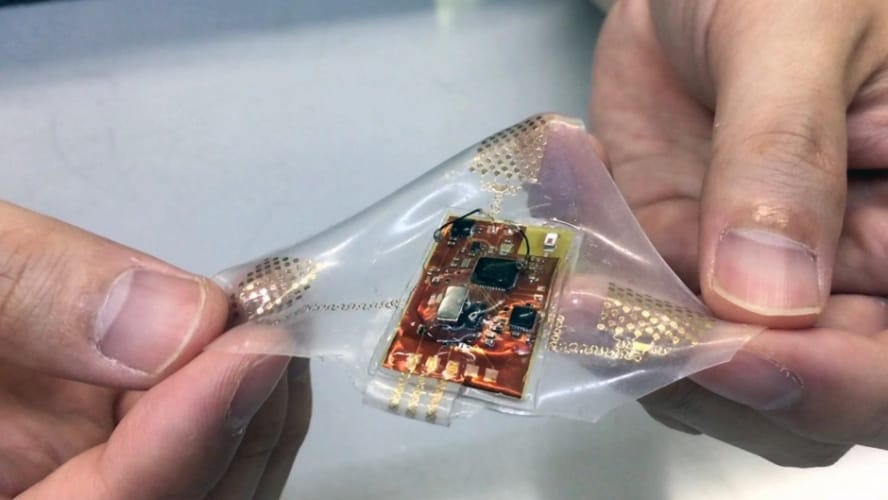According to its developers, the soft and conformable monitor can transmit electrocardiogram (ECG), heart rate, respiratory rate and motion activity data 15m to a smartphone or tablet computer. The electronics are mounted on a stretchable substrate and connected to gold, skin-like electrodes through printed connectors that can stretch with the medical film in which they are embedded. Details of the monitor are published in Advanced Science.
"This health monitor has a key advantage for young children who are always moving, since the soft conformal device can accommodate that activity with a gentle integration onto the skin," said Woon-Hong Yeo, an assistant professor in the George W. Woodruff School of Mechanical Engineering and Wallace H. Coulter Department of Biomedical Engineering at the Georgia Institute of Technology (GATECH). "This is designed to meet the electronic health monitoring needs of people whose sensitive skin may be harmed by conventional monitors."
Wearable technology seeks new materials to enhance functionalities
Because the device conforms to the skin, it avoids signal issues that can be created by the motion of the typical metal-gel electrodes across the skin. According to GATECH, the device can also obtain accurate signals from a person who is walking, running or climbing stairs.
"When you put a conventional electrode on the chest, movement from sitting up or walking creates motion artifacts that are challenging to separate from the signals you want to measure," Yeo said in a statement. "Because our device is soft and conformal, it moves with the skin and provides information that cannot be seen with the motion artifacts of conventional sensors."
The monitor uses three gold electrodes embedded in the film that also contains the electronic processing equipment. The entire health monitor is three inches in diameter, and a more advanced version under development will be half that size. The wireless monitor is powered by a small rechargeable battery, but future versions may replace the battery with an external radio-frequency charging system.

Yeo and his collaborators are focusing on paediatric applications because of the need for ambulatory monitoring in children. However, they envision that the health monitor could also be used for other patient groups, including older adults who may also have sensitive skin. For adults, there would be additional advantages.
"The monitor could be worn for multiple days, perhaps for as long as two weeks," Yeo said. "The membrane is waterproof, so an adult could take a shower while wearing it. After use, the electronic components can be recycled."
Two versions of the monitor have been developed. One is based on medical tape and designed for short-term use, while the other uses a soft elastomer medical film approved for use in wound care and can remain on the skin longer.
Because the monitor can be worn for long periods of time, it can provide a long-term record of ECG data helpful to understanding potential heart problems. "We use deep learning to monitor the signals while comparing them to data from a larger group of patients," Yeo said. "If an abnormality is detected, it can be reported wirelessly through a smartphone or other connected device."
Fabrication of the monitor's circuitry uses thin-film, mesh-like patterns of copper that can flex with the soft substrate. The chips are the only part not flexible, but they are mounted on the strain-isolated soft substrate instead of a traditional plastic circuit board.
As well as reducing its size, Yeo will now work toward a device that measures other health-related parameters such as temperature, blood oxygen and blood pressure.

Poll: Should the UK’s railways be renationalised?
I think that a network inclusive of the vehicles on it would make sense. However it remains to be seen if there is any plan for it to be for the...